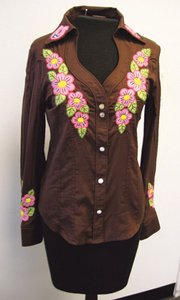Counteracting the Counterfeiters
U.S. Chamber of Commerce hosts anti-counterfeiting event in L.A.
Counterfeit goods steal a whopping $12 billion out of the U.S. apparel and footwear industry every year, eclipsing the motion-picture industry, which loses $6.1 billion, according to the U.S. Chamber of Commerce.
That doesn’t surprise Crystal Zarpas, an attorney whose apparel clients have seen the artwork on their blouses copied almost flower for flower by Chinese factories.
If you hold the blouses up side by side, it’s hard to tell the difference.
“The better the fakes, the more demand there is,” said Zarpas, a partner with Mann & Zarpas in Sherman Oaks, Calif. “And it’s not just the major brands any longer, but the small- and medium-sized manufacturers. They are getting their artwork stolen. You can’t protect the blouse [design], but the original artwork can be copyrighted.”
Zarpas was one of dozens of people who talked about counterfeiting and piracy at a nearly week-long seminar held Aug. 20–23 in and around Los Angeles. It was organized by the U.S. Chamber of Commerce, which has launched a major effort to curtail counterfeiting and piracy of goods manufactured and designed by U.S. companies.
The conference kicked off in downtown Los Angeles at the Westin Bonaventure Hotel, where Los Angeles Mayor Antonio Villaraigosa, L.A. City Attorney Rocky Delgadillo, U.S. Rep. Adam Schiff (D–Burbank, Calif.), and Los Angeles City Councilmembers Wendy Gruel and Jan Perry pledged to turn up the pressure to find and prosecute criminals who make fake goods and steal intellectual property.
“Piracy takes away jobs from industry and sales from stores and deprives artists of their earnings,” Villaraigosa said. “In a city like Los Angeles, some 450,000 jobs are related to the creative economy. It is not just entertainment, music and film but apparel, fashion and all the other related industries.”
A recent U.S. Chamber of Commerce–commissioned study conducted by the Gallup Organization showed one out of four people in Los Angeles purchased some kind of fake good in the past year—from knockoff purses on Santee Alley in the Fashion District to pirated DVDs sold on the sidewalks to fake pharmaceuticals sold over the Internet. That cost the local economy $5.2 billion, 106,000 jobs and $483 million in tax revenues in 2005.
A separate study by the Los Angeles County Economic Development Corp. showed counterfeiting in Los Angeles County in 2005 took its harshest toll on the motion-picture industry, with $2.75 billion in lost revenues. The music industry had $851 million in lost income, and the apparel, accessories and footwear industries had $617 million in lost sales.
Taking Action
Adidas International Inc., based in Germany and with U.S. headquarters in Portland, Ore., knows all about the financial toll of counterfeiters.
At a seminar about counterfeiters and piracy in Long Beach, Calif., Vanessa Backman from Adidas America Inc. shared her company’s experience with battling knockoffs and goods in the gray market.“Counterfeiters launch our products before the products launch or at the same time,” said the assistant general counsel of intellectual property.
Adidas recently debuted its David Beckham soccer jersey with the No. 23 on the back and the L.A. Galaxy logo on the front. Right away, counterfeiters were out there too, selling knockoffs of the shirt. “But they copied the wrong jersey, so it was easy to identify,” Backman said.
Adidas is constantly vigilant with intellectual-property teams in England, Germany, Amsterdam and Asia. The company aggressively deals with counterfeiters to make them understand they cannot get away with stealing.
“Make sure the factories where you are producing have a tight supply chain,” the Adidas attorney said. “Make sure things aren’t going out the back door.”She said an Adidas security label helps identify the factory that makes a legitimate branded item for the athletic apparel and footwear maker and helps determine if goods are being sold on the gray market outside of the company’s legal distribution channels.
Adidas takes an aggressive approach by raiding factories to make sure the manufacturer is turning over all the goods to Adidas and not a sidewalk vendor or store. The company also raids retailers selling counterfeit or gray-goods items.
“A factory can produce millions of pairs of shoes for a very low cost and at very high margins. The loss for them is the cost of doing business. But when the retailer is buying a shoe from a distributor for $10 to $20 and selling them for $30 and $40, it really impacts their business,” Backman said. “That is the strategy we have done, and it has been very successful.”
If retailers know their goods will be seized by Adidas, they often opt to sell a different brand whose company isn’t as aggressive about stopping illegal sales.
Piracy experts also urged manufacturers to teach customs officials and police officers how to determine whether an item is a knockoff or the real thing.
In February, Los Angeles city and county officials launched an anti-piracy task force to combat counterfeiting and piracy in the region.
Delgadillo said his office is exploring ways to go after property owners who knowingly allow the selling or manufacturing of counterfeit goods on their property.“This is clearly an illegal act they are allowing on their property,” the city attorney said.
Schiff, who co-founded the Congressional International Anti-Piracy Caucus, said in May the caucus unveiled an international piracy watch list of countries where piracy has reached alarming levels.
“China and Russia are two countries that stand out because of the scope and depth of their piracy problems,” Schiff said.
“We have specifically warned the White House that we cannot repeat the mistake we made with China by allowing Russia to enter the WTO [World Trade Organization] before they have clearly demonstrated a willingness and ability to provide the kind of copyright protection expected from a WTO partner.”























